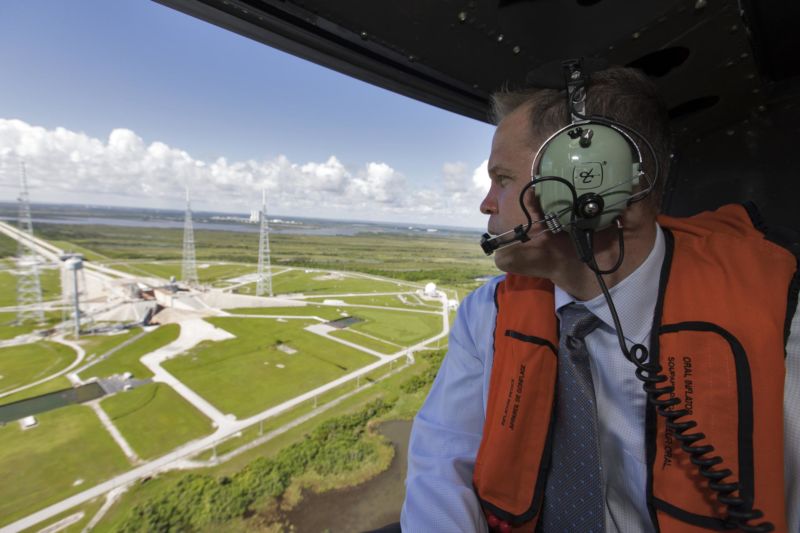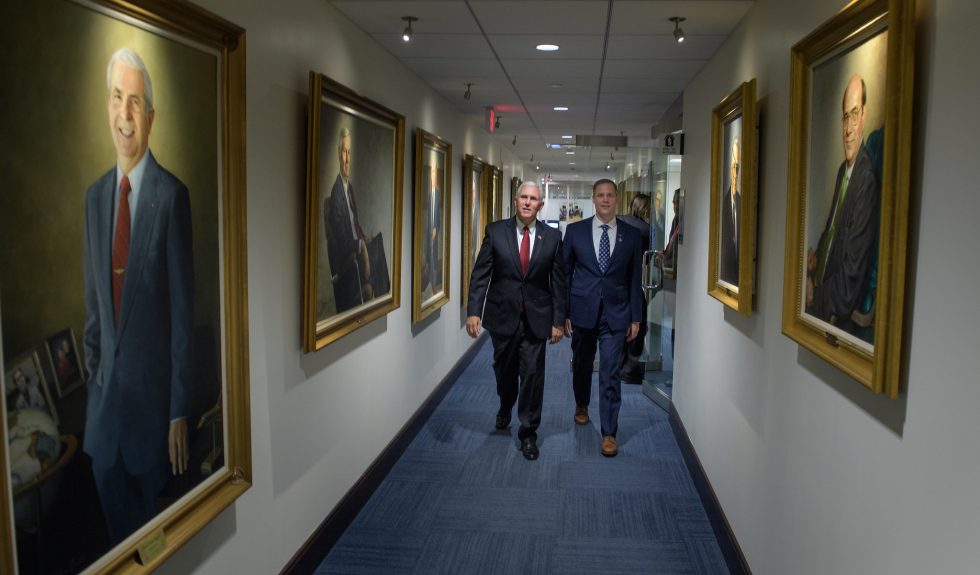
Speaking in front of a high-fidelity model of the Apollo program's Lunar Module spacecraft, Vice President Mike Pence charged NASA with accelerating its Moon plans last week. Instead of 2028, Pence wanted boots on the ground four years earlier, before the end of 2024. This marked the rarest of all moments in spaceflight—a schedule moving left instead of to the right.
Understandably, the aerospace community greeted the announcement with a healthy dose of skepticism. Many rocket builders, spaceship designers, flight controllers, and space buffs have seen this movie before. Both in 1989 and 2004, Republican administrations have announced ambitious Moon-then-Mars deep space plans only to see them die for lack of funding and White House backing.
And yet, this new proposal holds some promise. Pence, as well as NASA Administrator Jim Bridenstine, have adopted a clear goal for the agency and promised enduring political support. Moreover, they have said the “end” matters more than the “means.” This suggests that whatever rockets and spacecraft NASA uses to reach the Moon, the plan should be based on the best-available, most cost-effective technology. In short, they want to foster a healthy, open competition in the US aerospace industry to help NASA and America reach its goals.
At a town hall meeting Monday for space agency employees, Bridenstine characterized the Moon 2024 initiative as a “once-in-a-lifetime opportunity for NASA.” This may be a tad hyperbolic, but it does represent a rare chance for the sprawling bureaucratic federal agency—whose human exploration programs have been adrift for decades—to embrace a brighter future.
Therefore, this marks an important, if uncertain, moment in US spaceflight. To understand how we got here and where we're going, Ars has talked with a dozen well-placed sources in the aerospace industry, from new space companies and large aerospace contractors to senior NASA leaders and political insiders. Most of them are not named due to their sensitive positions; many of them see challenges ahead.
What is the plan?
Pence directed NASA to land humans at the lunar south pole by 2024. Most likely, this would be a two- or four-person crew that would include the first woman to visit the Moon. Landing near the poles is significant because the Apollo missions half a century ago stayed relatively close to the Moon’s equator, and NASA would like to understand whether water ice resources truly exist in abundance near the poles in shadowed craters.
The crew would descend to the lunar surface from an outpost in lunar orbit, known as the Gateway. Initially, these missions to the Moon would involve short sorties, but Pence also directed NASA to establish a permanent base on the surface of the Moon by 2028.
-
This gallery highlights how NASA hopes to land on the Moon by 2024.
-
NASA intends to use a three-stage lander that will descend to the surface from a Lunar Gateway.NASA
-
The Gateway will be put in a Near Rectilinear Halo Orbit, well above low-lunar orbit, due to limitations of SLS, Orion, and the spacecraft's service module.NASA
-
This is a concept design NASA was circulating in late 2018 for the Gateway.NASA
-
Under these plans, the Gateway more resembled the International Space Station than a small outpost. NASA Administrator Jim Bridenstine has said the Gateway must remain small, with the agency providing perhaps only the power and propulsion as well as a small habitat.NASA
-
Here's the power element.NASA
-
And some designs for the habitat module.NASA
-
These plans for a lander, released in February 2019, are already outdated. But they offer some sense of how NASA wants to get to the lunar surface from the Gateway.NASA
-
This involves a Transfer vehicle to get to low-lunar orbit, a Descent Vehicle, and an Ascent Vehicle.NASA
-
It's a bit complicated.NASA
During its lunar explorations, NASA and its astronauts would test technologies to survive and work in deep space for extended periods of time, beyond the relative safety of low-Earth orbit. By learning at the Moon, NASA could then develop plans that would allow humans to travel to Mars in the 2030s. Bridenstine insists that the agency has not lost sight of this goal.
What is behind this?
As Pence and Bridenstine have drilled deeper into the agency’s human exploration programs over the last year, they’ve grown frustrated at the pace of progress. A mid-March meeting with Boeing officials, during which the Space Launch System rocket’s prime contractor said they could not make a June 2020 test launch date, proved a breaking point.
Pence expressed this frustration during his Moon speech on March 26 at the US Space & Rocket Center in Huntsville, Alabama. In the 1960s, Pence said, the agency required just eight years to go to the Moon at a time when NASA didn't know how to do the job. Now, NASA has said it cannot land humans on the Moon before 2028, more than 11 years after President Trump first established the goal of returning humans to the lunar surface. "Ladies and gentlemen, that's just not good enough," Pence said. "We're better than that."
Neither Bridenstine nor Pence said so explicitly, but these comments reflect their sense that NASA has become too bureaucratic, too tentative, too risk averse. During his town hall this week, Bridenstine had a telling response when asked why, by setting such an ambitious goal of a 2024 landing, was he not putting schedule over safety?

“I would not say it’s a return to schedule over safety, I would say it’s a return to schedule,” he said. “Safety is paramount for everybody at this agency, it always has been. But the number one mission is not safety. If it was, we would all just stay in the ready room and just watch CNN.”
Pence and Bridenstine have challenged NASA to do better and sought to instill urgency into a human exploration program that has lacked it since the 1960s.
What happens next?
The agency’s leadership will try to move fast. Bridenstine has directed NASA’s chief of human spaceflight, William Gerstenmaier, to refine a plan of missions and vehicles that could meet the 2024 deadline. Meanwhile, Bridenstine is working with the White House and Office of Management to determine the costs.
The president already submitted his fiscal-year 2020 budget request to Congress more than three weeks ago, so the administration will have to amend the request with respect to NASA’s budget and then submit that to Congress. During a hearing on Tuesday, Bridenstine said he was hoping to get this amendment to Congress by April 15. This will provide the first outline of the new Moon program’s cost, although early estimates suggest it may require $2 to $4 billion annually on top of NASA’s present budget of $21 billion a year. Bridenstine said he does not want to steal from other parts of the agency's budget to pay for the initiative.
Bridenstine said he had buy-in from both Pence and President Trump for his plan but must still sell it to Congress. “Based upon the conversations I have had, the commitment from the administration is there. I can’t speak for Congress of course,” he said at the town hall.
Bagikan Berita Ini















0 Response to "Here’s why NASA’s audacious return to the Moon just might work - Ars Technica"
Post a Comment